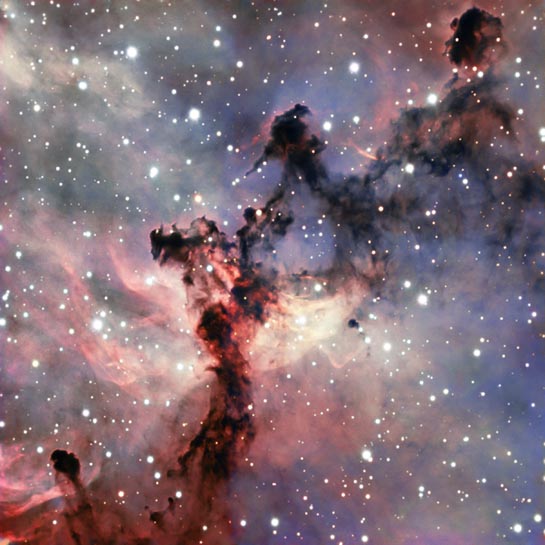
Emission nebula
RA 6h 30m 42.80s Dec 5° 0' 22.40"
Monoceros
5,000 light-years
9.0
80 x 50 arcmin
7.44 x 7.19 arcminutes
North is 90.0° right of vertical
ESO
November 19, 2018
2007 Spitzer: N0708 2010 WISE: N1030 2018 ESO: N1847
ABOUT THIS IMAGE:
This colorful image shows a part of the Rosette Nebula in the constellation of Monoceros (The Unicorn). It is an emission nebula, composed of clouds of gas that are made to glow by the radiation emanating from stars within. The Rosette Nebula is a fairly typical example of an emission nebula - but typical does not mean boring! Nebulae are some of the most beautiful celestial objects out there, and they frequently show up spectacularly in images taken by astronomical telescopes, as seen here.
In nebulae such as this, gas and dust are combining to produce a new generation of stars. Initially these newly-formed stars are shrouded in the dusty clouds that gave them birth, and cannot be seen in visible light. But after a while they blow away the denser material and their powerful radiation pours out to ionize the surrounding gas, causing it to glow brightly. These elements are all present in this image - the mixture of glowing gas and dark dust has been sculpted into complex patterns on the sky by the stellar radiation, like smoke around a fire.
This particular image was obtained with the FORS 2 instrument on ESO's Very Large Telescope, sited in the harsh environment of Chile's Atacama Desert. FORS 2 is an extremely versatile instrument that can produce very high-quality images (like this one!). It is also a spectrograph that can split the light it collects into a rainbow of colors, giving astronomers information about the chemical composition of objects across the Universe.
From Wikipedia:
The Rosette Nebula (also known as Caldwell 49) is a large spherical H II region (circular in appearance) located near one end of a giant molecular cloud in the Monoceros region of the Milky Way Galaxy. The open cluster NGC 2244 (Caldwell 50) is closely associated with the nebulosity, the stars of the cluster having been formed from the nebula's matter.
The complex has the following NGC designations:
NGC
2237 - Part of the nebulous region (Also used to denote whole nebula)
NGC 2238 - Part of the nebulous region
NGC 2239 - Part of the nebulous region (Discovered by John Herschel)
NGC 2244 - The open cluster within the nebula (Discovered by John Flamsteed
in 1690)
NGC 2246 - Part of the nebulous region
The cluster and nebula lie at a distance of some 5,000 light-years from Earth and measure roughly 130 light years in diameter. The radiation from the young stars excites the atoms in the nebula, causing them to emit radiation themselves producing the emission nebula we see. The mass of the nebula is estimated to be around 10,000 solar masses.
A survey of the nebula with the Chandra X-ray Observatory has revealed the presence of numerous new-born stars inside optical Rosette Nebula and studded within a dense molecular cloud. Altogether, approximately 2500 young stars lie in this star-forming complex, including the massive O-type stars HD 46223 and HD 46150, which are primarily responsible for blowing the ionized bubble. Most of the ongoing star-formation activity is occurring in the dense molecular cloud to the south east of the bubble.
A
diffuse X-ray glow is also seen between the stars in the bubble, which
has been attributed to a super-hot plasma with temperatures ranging from
1 to 10 million K. This is significantly hotter than the 10,000 K plasmas
seen in HII regions, and is likely attributed to the shock-heated winds
from the massive O-type stars.